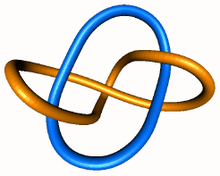- Link group
-
In knot theory, an area of mathematics, the link group of a link is an analog of the knot group of a knot. They were described by John Milnor in his Bachelor's thesis, (Milnor 1954).
Contents
Definition
The link group of an n-component link is essentially the set of (n + 1)-component links extending this link, up to link homotopy. In other words, each component of the extended link is allowed to move through regular homotopy (homotopy through immersions), knotting or unknotting itself, but is not allowed to move through other component. This is a weaker condition than isotopy: for example, the Whitehead link has linking number 0, and thus is link homotopic to the unlink, but it is not isotopic to the unlink.
It is not the fundamental group of the link complement, since the components of the link are allowed to move through themselves, though not each other, but thus is a quotient group of the link complement, since one can start with this, and then by knotting or unknotting components, some of these elements may become equivalent to each other.
Examples
The link group of the n-component unlink is the free group on n generators, Fn, as the link group of a single link is the knot group of the unknot, which is the integers, and the link group of an unlinked union is the free product of the link groups of the components.
The link group of the Hopf link, the simplest non-trivial link – two circles, linked once – is the free abelian group on two generators,
 Note that the link group of two unlinked circles is the free nonabelian group on two generators, of which the free abelian group on two generators is a quotient. In this case the link group is the fundamental group of the link complement, as the link complement deformation retracts onto a torus.
Note that the link group of two unlinked circles is the free nonabelian group on two generators, of which the free abelian group on two generators is a quotient. In this case the link group is the fundamental group of the link complement, as the link complement deformation retracts onto a torus.The Whitehead link is link homotopic to the unlink – though it is not isotopic to the unlink – and thus has link group the free group on two generators.
Milnor invariants
Milnor defined invariants of a link (functions on the link group) in (Milnor 1954), using the character
 which have thus come to be called "Milnor's μ-bar invariants", or simply the "Milnor invariants". For each k, there is an k-ary function
which have thus come to be called "Milnor's μ-bar invariants", or simply the "Milnor invariants". For each k, there is an k-ary function  which defines invariants according to which k of the links one selects, in which order.
which defines invariants according to which k of the links one selects, in which order.Milnor's invariants can be related to Massey products on the link complement (the complement of the link); this was suggested in (Stallings 1965), and made precise in (Turaev 1976) and (Porter 1980).
As with Massey products, the Milnor invariants of length k + 1 are defined if all Milnor invariants of length less than or equal to k vanish. The first (2-fold) Milnor invariant is simply the linking number (just as the 2-fold Massey product is the cup product, which is dual to intersection), while the 3-fold Milnor invariant measures whether 3 pairwise unlinked circles are Borromean rings, and if so, in some sense, how many times (i.e., Borromean rings have a Milnor 3-fold invariant of 1 or –1, depending on order, but other 3-element links can have an invariant of 2 or more, just as linking numbers can be greater than 1).
Another definition is the following: let's consider a link
 . Suppose that lk(Li,Lj) = 0;i,j = 1,2,3;i < j. Find any Seifert surfaces for link components- F1,F2,F3 correspondingly, such that
. Suppose that lk(Li,Lj) = 0;i,j = 1,2,3;i < j. Find any Seifert surfaces for link components- F1,F2,F3 correspondingly, such that  . Then the Milnor 3-fold invariant equals the number of triple points in
. Then the Milnor 3-fold invariant equals the number of triple points in  counting with signs.
counting with signs.Milnor invariants can sometimes be defined if the lower order invariants do not vanish, but then there is an indeterminacy, which depends on the values of the lower order invariants. This failure to be determined or indeterminacy can be understood two ways: algebraically, it is due to the indeterminacy of Massey products if lower order Massey products do not vanish; geometrically, it is due to the indeterminacy in expressing a link as a closed string link, as discussed below.
Milnor invariants can be considered as invariants of string links, in which case they are universally defined, and the indeterminacy of the Milnor invariant of a link is precisely due to the multiple ways that a given links can be cut into a string link; this allows the classification of links up to link homotopy, as in (Habegger & Lin 1990). Viewed from this point of view, Milnor invariants are finite type invariants, and in fact they (and their products) are the only rational finite type concordance invariants of string links; (Habegger & Masbaum 2000).
The number of linearly independent Milnor invariants of length k+1 is mNk − Nk + 1, where Nk is the number of basic commutators of length k in the free Lie algebra, namely:
where ϕ is the Möbius function, which was shown in (Orr 1989). This grows on the order of mk + 1 / k2.
Applications
Link groups can be used to classify Brunnian links.
See also
References
- Habegger, Nathan; Lin, X.S. (1990), "The classification of links up to homotopy", Journal of the American Mathematical Society, 2 (American Mathematical Society) 3 (2): 389–419, doi:10.2307/1990959, JSTOR 1990959
- Habegger, Nathan; Masbaum, Gregor (2000), "The Kontsevich integral and Milnor's invariants", Topology 39: 1253–1289, doi:10.1016/S0040-9383(99)00041-5, preprint.
- Milnor, John (March 1954), "Link Groups", Annals of Mathematics (Annals of Mathematics) 59 (2): 177–195, doi:10.2307/1969685, JSTOR 1969685
- Orr, Kent E. (1989), "Homotopy invariants of links", Inventiones Mathematicae 95: 379–394, doi:10.1007/BF01393902
- Porter, R. (1980), "Milnor's μ-invariants and Massey products", Transactions of the American Mathematical Society (American Mathematical Society) 257 (1): 39–71, doi:10.2307/1998124, JSTOR 1998124
- Stallings, John R. (1965), "Homology and central series of groups", Journal of Algebra 2: 170–181, doi:10.1016/0021-8693(65)90017-7
- Turaev, V. G. (1976), "The Milnor invariants and Massey products", Studies in Topology-II 66: 189–203
Categories:
Wikimedia Foundation. 2010.



